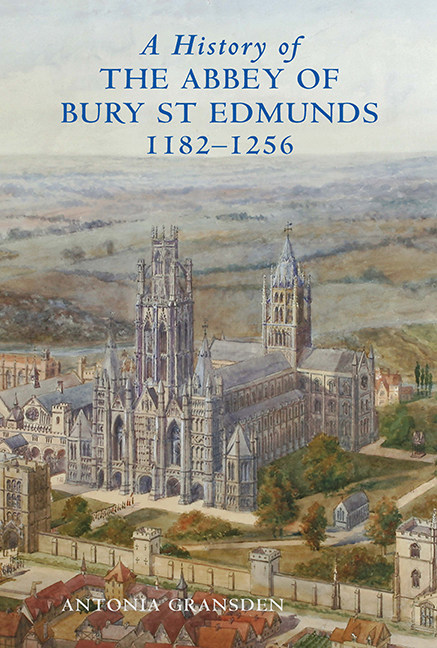Book contents
- Frontmatter
- Dedication
- Contents
- List of plates
- List of figures
- Preface
- Editorial Note
- Epigraph
- Acknowledgements
- Maps and plans (figures 1–9)
- Part I Samson of Tottington, Abbot 1182–1211
- PART II The Abbey 1212–1256
- 14 The vacancy, 1211–15, and election of Hugh of Northwold
- 15 The Abbots 1215–1256
- 16 Observance of the Rule of St Benedict
- 17 Learning
- 18 Books
- 19 Buildings
- 20 St Edmunds’ liberties and the Crown
- 21 Henry III and the cult of St Edmund
- APPENDICES
20 - St Edmunds’ liberties and the Crown
from PART II - The Abbey 1212–1256
Published online by Cambridge University Press: 29 April 2017
- Frontmatter
- Dedication
- Contents
- List of plates
- List of figures
- Preface
- Editorial Note
- Epigraph
- Acknowledgements
- Maps and plans (figures 1–9)
- Part I Samson of Tottington, Abbot 1182–1211
- PART II The Abbey 1212–1256
- 14 The vacancy, 1211–15, and election of Hugh of Northwold
- 15 The Abbots 1215–1256
- 16 Observance of the Rule of St Benedict
- 17 Learning
- 18 Books
- 19 Buildings
- 20 St Edmunds’ liberties and the Crown
- 21 Henry III and the cult of St Edmund
- APPENDICES
Summary
Jurisdictional liberties
The Liberty of St Edmunds, which comprised both the Liberty of the eight and a half hundreds and the even more highly privileged Liberty of the banleuca, was well-established before the Norman Conquest and had been confirmed by the Anglo-Norman kings and their successors. St Edmunds’ claim to the Liberty was based primarily on the grants by Edward the Confessor but these were expressed in general terms, and in the twelfth and thirteenth centuries frequent definition and elaboration were necessary in order to accommodate new developments in royal government. For instance, there was the problem of that characteristic feature of the judicial system of the late twelfth and thirteenth centuries, the general eyre. How could the abbot's claim to jurisdiction in the Liberty be reconciled with the visits of itinerant justices? Because of the privilege that no minister of the king could exercise authority within the banleuca; thus, the abbot could exclude them from the town of Bury St Edmunds itself and appoint his own justices in eyre. But he could not exclude them from the Liberty of the eight and a half hundreds. For that, the royal justices held special sessions at Cattishall (an open place three and a half miles south-east of Bury). A point of contention between abbot and king was which of them was entitled to the profits of justice accruing from those sessions, notably amercements and the chattels of felons. Such profits normally belonged to the king but the abbot claimed them as part of the regalian rights of the Liberty of the eight and a half-hundreds. Similarly, the convent claimed them in cases involving its manors and tenants within the Liberty. Moreover, the abbot claimed the right to the profits of justice in cases arising in royal or honorial courts outside the Liberty if St Edmunds’ holdings or tenants were at issue. The thirteenth-century abbots of St Edmunds, like other liberty-holders, struggled at the Exchequer to establish their right in face of the king's quo warranto proceedings, appealing to their charters and to precedents. This struggle began in the first half of the thirteenth century and culminated in the victory of Abbot John of Northwold in 1290.
- Type
- Chapter
- Information
- A History of the Abbey of Bury St Edmunds, 1182–1256Samson of Tottington to Edmund of Walpole, pp. 236 - 244Publisher: Boydell & BrewerPrint publication year: 2007



